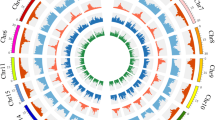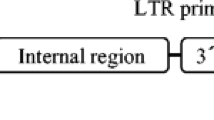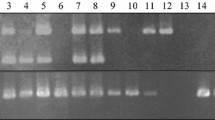Abstract
In the rice genome, insertions and eliminations of transposable elements have generated numerous transposon insertion polymorphisms (TIPs). Common wild rice (O. rufipogon Griff.), the ancestor of Asian cultivated rice (O. sativa L.), carries abundant genetic variations. To find subspecies-specific (SS) markers that can distinguish O. sativa ssp. indica and ssp. japonica, some long terminal repeat (LTR) sequences (sc1-14) of AA genome-specific RIRE retrotransposon were isolated from O. rufipogon genome. Sequences sc1 and sc12 were successfully utilized to develop the SS marker system based on retrotransposon inserted position polymorphisms. Twenty-two SS markers (ssi1-9, ssj1-13) were developed, where ssi1-9 are the indica-specific types, and ssj1-13 the japonica-specific types. The average accuracy of these markers in distinguishing the two subspecies is over 85%. SS marker ssj-10 can distinguish the two subspecies at 100% accuracy. Principal component analysis (PCA) showed that these markers could successfully distinguish indica from japonica varieties, regardless of their geographical origin.





Similar content being viewed by others
Abbreviations
- SS marker:
-
Subspecies-specific markers
- LTR:
-
Retrotransposon long terminal repeat
- PCA:
-
Principal component analysis
- RBIPs:
-
Retrotransposon-based insertion polymorphisms
- ICD:
-
Integrase coding domain
- TEs:
-
Transposable elements
- RT:
-
Reverse transcriptase
- RFLP:
-
Restriction fragment length polymorphism
- RAPD:
-
Random amplified polymorphic DNA
- SSR:
-
Simple sequence repeat
- SNP:
-
Single nucleotide polymorphism
References
Britten RJ, Rowen L, Williams J, Cameron RA (2003) Majority of divergence between closely related DNA samples is due to indels. PNAS 100:4661–4665
Chang TT (1976) The origin, evolution, cultivation, dissemination, and diversification of the Asian and African rices. Euphytica 25:425–441
Chin JH, Kim JH, Jiang WZ, Chu SH, Woo MO, Han LZ, Brar DS, Koh HJ (2007) Identification of subspecies-specific STS markers and their association with segregation distortion in rice (Oryza sativa L.). J Crop Sci Biotech 10:175–184
Edwards K, Johnstone C, Thompson C (1991) A simple and rapid method for plant DNA preparation. Nucleic Acids Res 19:1349
Flavell AJ, Pearce SR, Kumar A (1994) Plant transposable elements and the genome. Curr Opin Genet Dev 4:838–844
Flavell AJ, Knox MR, Pearce SR, Noel Ellis TH (1998) Retrotransposon-based insertion polymorphisms (RBIP) for high throughput marker analysis. Plant J 16:643–650
Garris AJ, Tai TH, Coburn J, Kresovich S, McCouch SR (2005) Genetic structure and diversity in Oryza sativa L. Genetics 169:1631–1638
Ge S, Sang T, Lu B, Hong DY (1999) Phylogeny of rice genomes with emphasis on origins of allotetraploid species. Proc Natl Acad Sci 96:14400–14405
Hong YH, Qian K, Qin QL, Chen JM (2006) Cloning and analysis of a repetitive DNA from Dong **ang wild rice (Oryza rufipogon Griff.) and its chromosomal localization. J Yangzhou Univ 27:56–61
**g RC, Knox MR, Lee JM, Vershinin AV, Ambrose M, Ellis TH, Flavell AJ (2005) Insertional polymorphism and antiquity of PDR1 retrotransposon insertions in Pisum species. Genetics 171:741–752
Khush GS (1997) Origin, dispersal, cultivation and variation of rice. Plant Mol Biol 35:25–34
Kumekawa N, Ohtsubo H, Horiuchi T, Ohtsubo E (1999) Identification and characterization of novel retrotransposons of the gypsy type in rice. Mol Gen Genet 260:593–602
Kunze R, Saedler H, Lönnig W-E (1997) Plant transposable element. Adv Bot Res 27:331–370
Kwon SJ, Park KC, Kim JH, Lee JK, Kim NS (2005) Rim 2/Hipa CACTA transposon display: a new genetic marker technique in Oryza species. BMC Genet 6:1–15
Lee JK, Kwon SJ, Park KC, Kim NS (2005) Isaac-CACTA transposons: new genetic markers in maize and sorghum. Genome 48:455–460
Liu XC, Ishiki K, Wang WX (2002) Identification of AFLP markers favorable to heterosis in hybrid rice. Breed Sci 52:201–206
Londo JP, Chiang YC, Hung KH, Chiang TY, Schaal BA (2006) Phylogeography of Asian wild rice, Oryza rufipogon, reveals multiple independent domestications of cultivated rice, Oryza sativa. PNAS 103:9578–9583
Ma JX, Devos K, Bennetzen JL (2004) Analyses of LTR-retrotransposon structures reveal recent and rapid genomic DNA loss in rice. Genome Res 14:860–869
Mao L, Wood TC, Yu Y, Muhammad A, Budiman MA, Tomkins J, Woo SS, Sasnowski M, Presting G, Frisch D, Goff S, Dean RA, Wing RA (2009) Rice transposable elements: a survey of 73, 000 sequence-tagged-connectors. Genome Res 10:982–990
McNally KL, Childs KL, Bohnert R, Davidson RM, Zhao K, Ulat VJ, Zeller G, Clark RM, Hoen DR, Bureau TE, Stokowski R, Ballinger DG, Frazer KA, Cox DR, Padhukasahasram B, Bustamante CD, Weigel D, Mackill DJ, Bruskiewich RM, Rätsch G, Buell CR, Leung H, Leach JE (2009) Genome wide SNP variation reveals relationships among landraces and modern varieties of rice. PNAS 106:12273–12278
Monna L, Ohta R, Masuda H, Koike A, Minobe Y (2006) Genome-wide searching of single-nucleotide polymorphisms among eight distantly and closely related rice cultivars (Oryza sativa L.) and a wild accession (Oryza rufipogon Griff.). DNA Res 13:43–51
Neeraja CN, Malathi S, Siddiq EA (2006) Subspecies-specific microsatellite markers for rice (Oryza sativa L.). J Plant Biochem Biotechnol 15
Oka HI, Chang WT (1959) The impact of cultivation on populations of wild rice, Oryza sativa f. spontanea. Phyton 13:105–117
Oka HI, Chang TT (1962) Rice varieties intermediate between wild and cultivated forms and the origin of the Japonica type. Bot Bull Acad Sin 3:109–131
Porceddu A, Albertini E, Barcaccia G, Marconi G, Bertoli FB, Veronesi F (2002) Development of S-SAP markers based on an LTR-like sequence from Medicago sativa L. Mol Genet Genom 267:107–114
Qian HR, Zhuang JY, Lin HX, Lu J, Zheng KL (1995) Identification of a set of RFLP probes for subspecies differentiation in Oryza sativa L. Theor Appl Genet 90:878–884
Queen RA, Gribbon BM, James C, Jack P, Flavell AJ (2004) Retrotransposon-based molecular markers for linkage and genetic diversity analysis in wheat. Mol Gen Genom 271:91–97
Rakshit S, Rakshit A, Matsumura H, Takahashi Y, Hasegawa Y, Ito A, Ishii T, Miyashita NT, Terauchi R (2007) Large-scale DNA polymorphism study of Oryza sativa and O. rufipogon reveals the origin and divergence of Asian rice. Theor Appl Genet 114:731–743
SanMiguel P, Tikhanov A, ** YK, Motchoulskaia N, Zakharov D, Melake-Berhan A, Springer PS, Edwards KJ, Lee M, Avramova Z, Bennetzen JL (1996) Nested retrotransposons in the intergenic regions of the maize genome. Science 274:765–768
Schulman AH, Kalendar R (2005) A movable feast: diverse retrotransposons and their contribution to barley genome dynamics. Cytogenet Genome Res 110:598–605
Second G (1982) Origin of the genic diversity of cultivated rice (Oryza spp.): study of the polymorphism scored at 40 isozyme loci. Jpn J Genet 57:25–57
Shcherban AB, Vaughan DA, Tomooka N (2000) Isolation of a new retrotransposon- like DNA sequence and its use in analysis of diversity within the Oryza officinalis complex. Genetica 108:145–154
Sun CQ, Wang XK, Yoshimura A, Doi K (2002) Genetic differentiation for nuclear, mitochondrial and chloroplast genomes in common wild rice (Oryza rufipogon Griff.) and cultivated rice (Oryza sativa L.). Theor Appl Genet 104:1335–1345
Syed NH, Sureshsundar S, Wilkinson MJ, Bhau BS, Cavalcanti JJV, Flavell AJ (2005) Ty1-copia retrotransposon-based SSAP marker development in cashew (Anacardium occidentale L.). Theor Appl Genet 110:1195–1202
Vinatzer BA, Zhang HB, Sansavini S (1998) Construction and characterization of a bacterial artificial chromosome library of apple. Theor Appl Genet 97:1183–1190
Vitte C, Panaud O (2003) Formation of Solo-LTRs through unequal homologous recombination counterbalances amplifications of LTR retrotransposons in Rice Oryza sativa L. Mol Biol Evol 20:528–540
Vitte C, Ishii T, Lamy F, Brar D, Panaud O (2004) Genomic paleontology provides evidence for two distinct origins of Asian rice (Oryza sativa L.). Mol Gen Genom 272:504–511
Vos P, Hogers R, Bleeker M, Reijans M, Lee TVD, Hornes M, Frijters A, Pot J, Peleman J, Kupier M, Zabeau M (1995) AFLP: a new technique for DNA fingerprinting. Nucleic Acids Res 23:4407–4414
Wang ZY, Second G, Tanksley SD (1992) Polymorphism and phylogenetic relationships among species in the genus Oryza as determined by analysis of nuclear RFLPs. Theor Appl Genet 83:565–581
Waugh R, McLean K, Flavell AJ, Pearce SR, Kumar A, Thomas BB, Powell W (1997) Genetic distribution of BARE-1-like retrotransposable elements in the barley genome revealed by sequence-specific amplification polymorphisms (S-SAP). Mol Gen Genet 253:687–694
Yu LX, Nguyen HT (1994) Genetic variation detected with RAPD markers among upland and lowland rice cultivars (Oryza sativa L.). Theor Appl Genet 87:668–672
Zhang QF, Maroof MAS, Lu TY, Shen BZ (1992) Genetic diversity and differentiation of indica and japonica rice detected by RFLP analysis. Theor Appl Genet 83:495–499
Zhang Q, Gao YJ, Yang SH, Ragab RA, Maroof MAS, Li ZB (1994) A diallel analysis of heterosis in elite hybrid rice based on RFLPs and microsatellites. Theor Appl Genet 89:185–192
Zhang D, Zhang H, Wang M, Sun J, Qi Y, Wang F, Wei X, Han L, Wang X, Li Z (2009) Genetic structure and differentiation of Oryza sativa L. in China revealed by microsatellites. Theor Appl Genet 119:1105–1117
Zhao X, Yang L, Zheng Y, Xu Z, Wu W (2009) Subspecies-specific intron length polymorphism markers reveal clear genetic differentiation in common wild rice (Oryza rufipogon L.) in relation to the domestication of cultivated rice (O. sativa L.). J Genet Genom 36:435–442
Acknowledgments
The research was supported by IAEA (12228/RO).
Author information
Authors and Affiliations
Corresponding author
Rights and permissions
About this article
Cite this article
**ao, N., Sun, G., Hong, Y. et al. Cloning of genome-specific repetitive DNA sequences in wild rice (O. rufipogon Griff.), and the development of Ty3-gypsy retrotransposon-based SSAP marker for distinguishing rice (O. sativa L.) indica and japonica subspecies. Genet Resour Crop Evol 58, 1177–1186 (2011). https://doi.org/10.1007/s10722-010-9651-8
Received:
Accepted:
Published:
Issue Date:
DOI: https://doi.org/10.1007/s10722-010-9651-8




